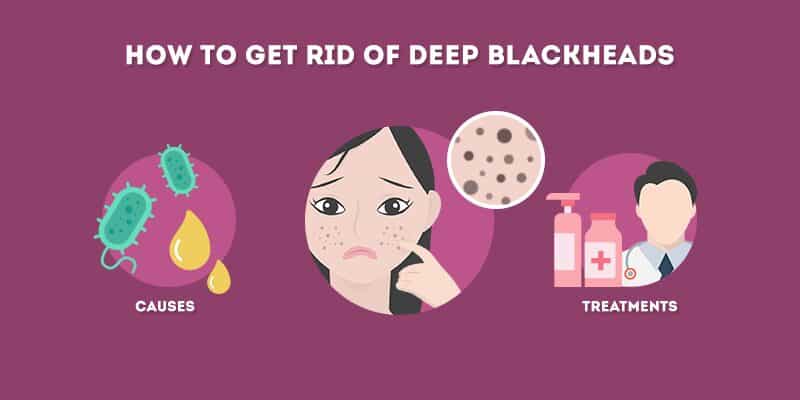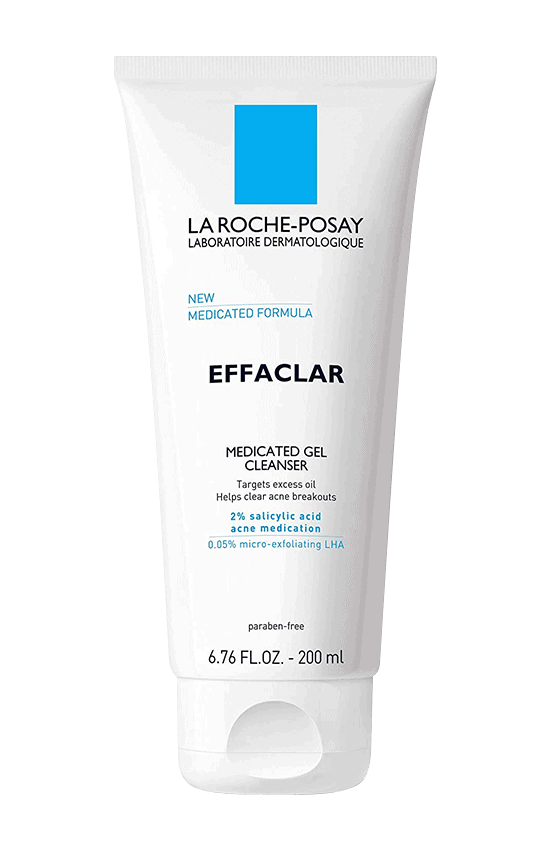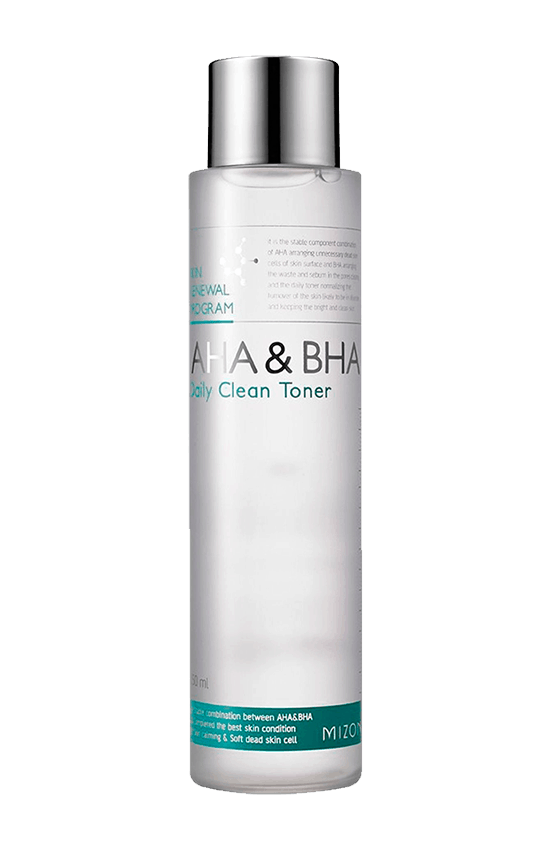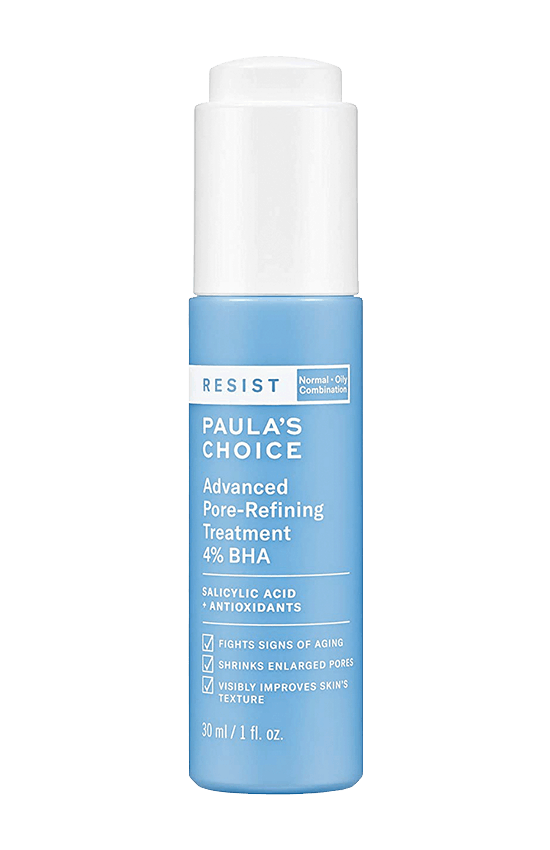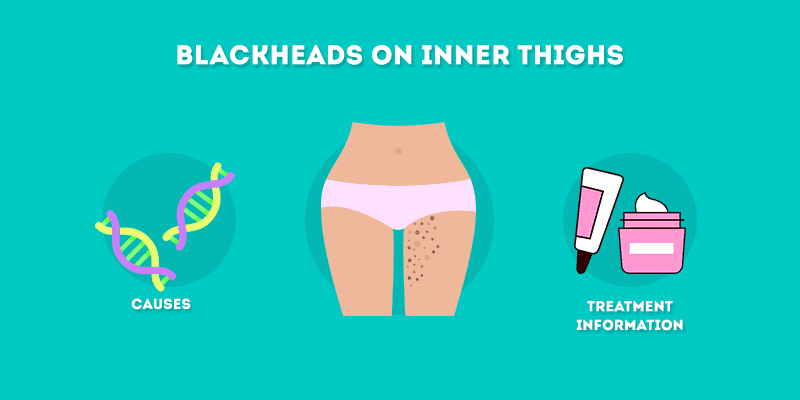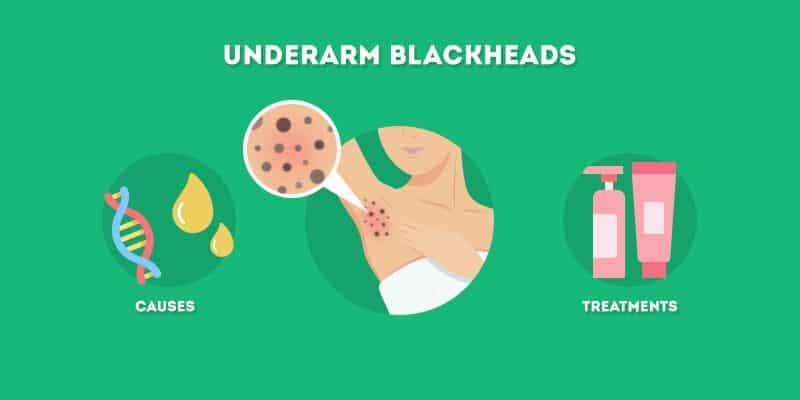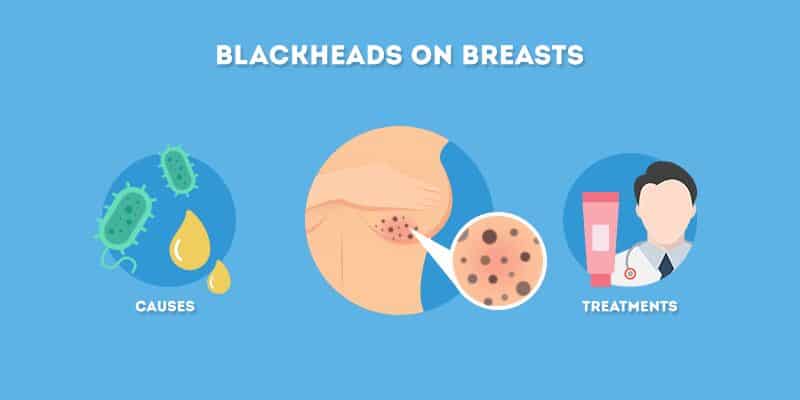Blackheads are annoying. But when you’re dealing with deep blackheads that won’t seem to go away, things can get to a whole new level of frustration. While they may seem impossible to treat, thankfully, it is possible to deal with these blackheads.
Learn more about how to get rid of deep blackheads, and the preventative steps you can take to keep them at bay.
What Are Blackheads?
Blackheads form when a pore becomes clogged with debris. This debris includes sebum, bacteria, dirt, dead skin cells, sweat, makeup, and sunscreen. When left untreated, it is possible for these blackheads to get bigger and deeper. It is a common misconception that the black or gray color comes from dirt. However, blackheads get their color when the pore-clogging debris is exposed to oxygen.
What Causes Deep Blackheads?
There are a variety of factors that cause deep blackheads to form. Some people are simply more genetically predisposed to getting blackheads. Hormonal changes can also play a part in blackheads forming. When the body is experiencing hormonal changes (such as with puberty, pregnancy, menopause, and perimenopause, and with the use of oral contraceptives), it is often triggered to produce more oil. This excess oil can clog the pores, leading to blackheads.
And, by not taking care of your blackheads, they may develop into deep blackheads. However, this is only the case for some people. As I discussed in my article "What Happens If You Don't Remove Blackheads", everyone's skin is different, thus why some people develop deep blackheads, and others do not.
Other Causes
- External factors can also play a part in the development of blackheads
- Talking on the phone with a dirty screen
- Sleeping on dirty pillow cases and sheets
- Neglecting to properly cleanse your face on a daily basis, you might experience more blackheads
- Certain comedogenic (pore-clogging) products – like makeup products, sunscreens, or lotions – could also lead to blackheads
How to Get Rid of Deep Blackheads (At Home)
The best way to get rid of deep blackheads is by following a proper skincare routine. By following a proper skincare routine, you will also prevent them from coming back. There are two vital steps in the prevention of blackheads: cleansing and exfoliating.
1. Cleansing
Cleansing is an incredibly important step in blackhead prevention. A good cleanser will sweep away debris that could potentially clog the pores and cause blackheads.
2. Exfoliating
When looking at how to get rid of deep blackheads and prevent them from forming in the first place, exfoliating is the other piece of the puzzle. Exfoliating gets rid of the debris both on the surface of the skin and inside the pores. There are two methods of exfoliation:
- Mechanical Exfoliation: This involves the use of a tool (like a sponge or scrubbing cleanser) to physically dislodge the debris on the skin. The danger with mechanical exfoliation is that it can be tempting to harshly scrub. In order to get rid of blackheads but avoid irritation and redness, you need to use a gentle touch.
- Chemical Exfoliation (Preferred): On the other hand, chemical exfoliation involves using a topical product that exfoliates the skin. Exfoliating products may contain salicylic acid, which is a beta hydroxy acid (BHA), and/or alpha hydroxy acids (AHA), like glycolic acid. These ingredients work by dissolving anything that might be holding dead skin onto the surface and unclogging the debris in the pores. Salicylic acid is particularly powerful when it comes to deep blackheads. It is oil-soluble and able to penetrate deep into the pores, getting to the source of the problem.
3. Manual Extraction
The third and final way to getting rid of deep blackheads is with the use of a comedone extractor. A comedone extractor specifically designed to extract deep blackheads, so it is the safest approach to extraction. Additionally, it is much safer than using your fingers.
Best Products for Deep Blackheads
There are some great at-home options you can use to treat deep blackheads and prevent new ones from forming. Here are the top products and treatments to check out.
1. Paula’s Choice Skin Perfecting 2% BHA Liquid (Blackheads)
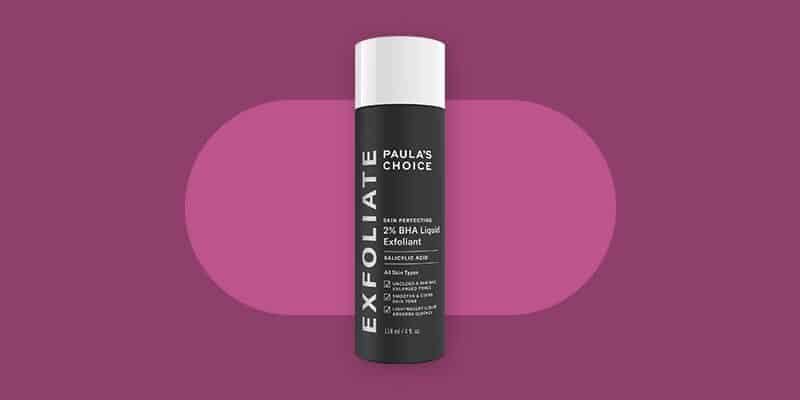
Best for: getting rid of and preventing deep blackheads
This product is incredibly popular for a reason: it effectively treats and prevents blackheads. The key ingredient is salicylic acid, which is able to dive deep into the pores to break up any clogs that are causing blackheads. The 2% concentration is ideal for many people, as it is effective but still gentle on the skin.
How to Use: Apply the product on clean, dry skin. Soak a cotton ball or round, and sweep the product across any areas that are prone to or experiencing blackheads. Do not wash it off after applying. Use 1 to 2 times daily, and follow up with a non-comedogenic moisturizer. Use consistently to prevent new blackheads from forming.
2. Paula’s Choice Resist Advanced Pore-Refining Treatment 4% BHA (Stubborn Blackheads)
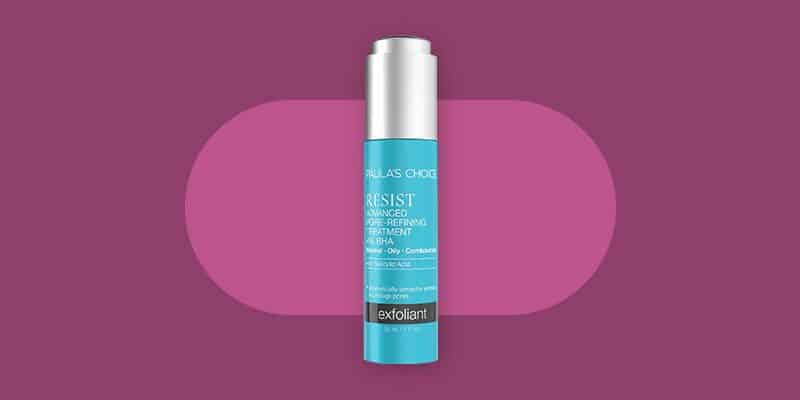
Best for: getting rid of and preventing stubborn deep blackheads
If you are looking for something a bit stronger, this is the next step up from the Paula’s Choice 2% BHA Liquid. Since it has a 4% concentration of salicylic acid, it may be more effective on more stubborn blackheads. However, since it is stronger, it is more likely to have a drying effect on the skin. At first, try applying it every other day, and then working up to daily and twice daily use if necessary.
How to Use: Apply the product on clean, dry skin. Soak a cotton ball or round, and sweep the product across any areas that are prone to or experiencing blackheads. Do not wash it off after applying. Follow up with a non-comedogenic moisturizer. Use consistently to prevent new blackheads from forming.
3. My Konjac Sponge (Preventing Blackheads)
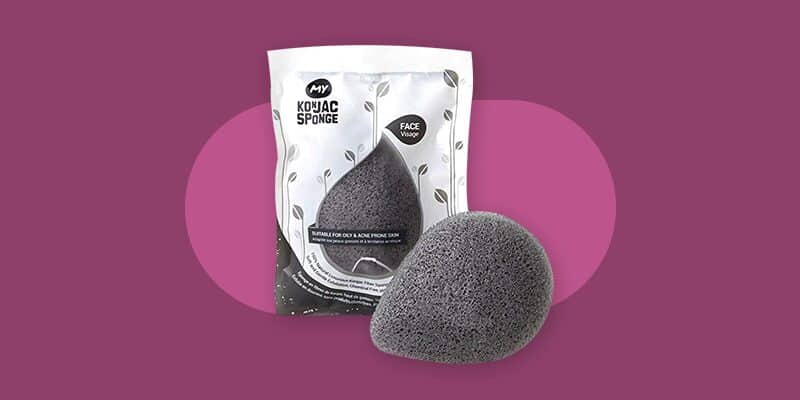
Best for: daily skincare and preventing blackheads from developing
A konjac sponge is particularly useful for treating blackheads on the body. This mechanical exfoliator is gentle on the skin, but able to effectively get rid of debris. My Konjac Sponge is made with activated charcoal, which is also beneficial for treating blackheads. Charcoal draws out oil and debris from the pores, giving a deeper cleanse.
How to Use: Use this sponge with a gentle cleanser. While taking a shower, get the sponge wet, and then add cleanser. Gently scrub the sponge on the affected areas to get an exfoliating cleanse.
4. BESTOPE Blackhead Remover Tool (Stubborn Deep Blackheads)

Best for: getting rid of and preventing stubborn deep blackheads
If you are tempted to get rid of your blackheads with your own hands, a comedone extractor may be a useful tool for you. Many try simply using their fingers, but this can do more harm than good. Using your fingers to extract blackheads can spread bacteria, irritate the skin, and even cause more damage. This tool is specifically designed to extract blackheads, so it is the safest approach to extraction.
How to Use: Start with a clean, dry face and a sanitized comedone extractor. Place the extractor around a blackhead. Gently press down on one side, and then roll to the other side of the blackhead to extract. If your blackhead isn’t coming out this time, leave it be. Being too forceful can irritate and even harm the skin. Disinfect the tool once finished to prevent the spread of bacteria.
How to Get Rid of Deep Blackheads (Professional Options)
While at-home products can be effective, when it comes to treating deep blackheads, they might not be enough. You might not be able to get to blackheads that are deep in the pores, so getting treatment and advice from a professional may be your best bet. If you are looking to bring out the big guns, there are a few effective professional options you can try out to get rid of deep blackheads.
1. Chemical Peels
During a chemical peel, a solution is applied to the skin. This solution deeply exfoliates the pores and surface of the skin, revealing rejuvenated skin underneath. Peels will typically consist of a combination of AHAs and BHAs. There are different strengths of chemical peels. The stronger peels cause the skin to peel off in the days following the treatment. When you meet with the professional giving the treatment, they will determine the best formula and strength for your needs. You can typically do a chemical peel at a dermatologist’s office or a medical spa.
2. Extraction Facial
If you are looking into how to get rid of deep blackheads, an acne-focused facial may be a great choice for you. For those with acne-prone skin, extractions are normally a part of a facial with a trained esthetician or dermatologist. They will cleanse and steam the skin, and then use a tool to manually extract blackheads.
When to See a Dermatologist
If you’ve exhausted all your options and can’t seem to tackle your blackheads, it might be best to make an appointment with a dermatologist. They’ll be able to assess your skin’s unique needs, and create an action plan for effectively treating and preventing your blackheads.
FAQs
What happens to blackheads if not removed?
When you don’t treat blackheads, they can get deeper over a period of time. Debris can continue to collect in the pores, causing blackheads that appear bigger and deeper. They may also be harder to treat down the line, so it is best to treat and take preventative steps sooner rather than later.
How do you remove a deep blackhead?
There are a variety of treatment options to get rid of deep blackheads. Chemical exfoliants – particularly those with salicylic acid – can be particularly useful for getting rid of deep blackheads. You can also use a comedone extractor to gently bring blackheads to the surface to remove them manually. For deep blackheads on the body, a manual exfoliator like a konjac sponge can be very effective.
How do you get rid of a stubborn blackhead?
If you find that you aren’t able to get rid of a stubborn blackhead with any at-home treatments, it may be time to seek advice from a professional. A dermatologist can help you determine a course of action for treating any pesky blackheads. You may need a treatment like a chemical peel, or a prescription-strength topical.
Summary: How to Get Rid of Deep Blackheads
- Follow a proper skincare routine of cleansing and exfoliating
- Use the right products to prevent deep blackheads from developing
- Be consistent with your skincare routine
- Use BHAs and a comedone extractor to get rid of deep blackheads
The Bottom Line
- Blackheads can be caused by a variety of factors, including genetic predisposition, hormonal changes, and external factors.
- When looking at how to get rid of deep blackheads, there are two approaches you can take: at-home and professional treatments.
- For those with deep blackheads, a professional treatment may be the best option.
- Once blackheads are clear, it is necessary to take preventative steps. Those prone to blackheads should cleanse and exfoliate regularly.
